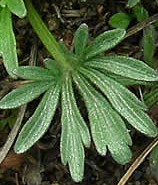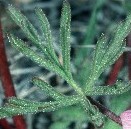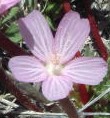 Ped A ta from Latin pes, pedis meaing foot
Ped A ta from Latin pes, pedis meaing foot
The term is used to describe plant structures, often leaves, that are divided so that they resemble a bird’s foot, with a few divisions radiating from a central point. The divisions differ in number, length and width depending on the species.
There are numerous plants that have leaves that can be described as pedate but only some of them have the term as the specific epithet.
Bird’s Foot Violet (Viola pedata)
 This charming spring blooming wild flower native to eastern North America is two to six inches tall, and has leaves that are palmately divided into three to five segments. The flowers are ¾ to 1 ½ inch across, and have two dark violet upper petals three pale lilac lower
This charming spring blooming wild flower native to eastern North America is two to six inches tall, and has leaves that are palmately divided into three to five segments. The flowers are ¾ to 1 ½ inch across, and have two dark violet upper petals three pale lilac lower  petals clustered around five orange stamens.
petals clustered around five orange stamens.
Lady’s Mantle (Alchemilla pedata)
 This species of lady mantle is native to Ethiopia where it grows in grassy places and on the edges of forests. It spreads by runners to form a mass over a yard across. Its leaves are deeply lobed into seven to nine segments, and are toothed. The flowers are small, dull yellow and held in loose racemes. Not considered garden worthy by many.
This species of lady mantle is native to Ethiopia where it grows in grassy places and on the edges of forests. It spreads by runners to form a mass over a yard across. Its leaves are deeply lobed into seven to nine segments, and are toothed. The flowers are small, dull yellow and held in loose racemes. Not considered garden worthy by many.
Bird’s Foot Checkerbloom (Sidalcea pedata)
 Endemic to the San Bernardino Mountains of California, this perennial herb grows in moist meadows to open woodlands and the pebble plain of the area. The basal leaves are ternately divided into
Endemic to the San Bernardino Mountains of California, this perennial herb grows in moist meadows to open woodlands and the pebble plain of the area. The basal leaves are ternately divided into  five to seven parts. The rose pink flowers are marked with darker colored
five to seven parts. The rose pink flowers are marked with darker colored
veins and are carried in a spike like raceme.